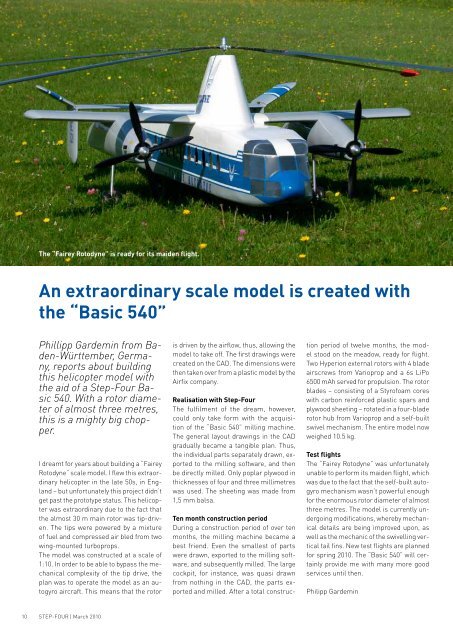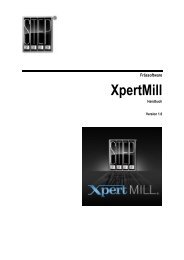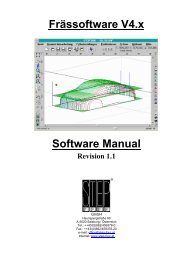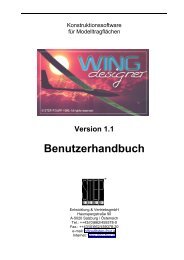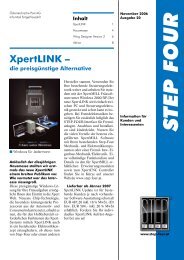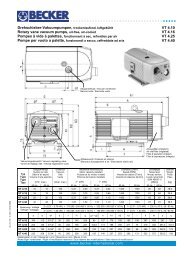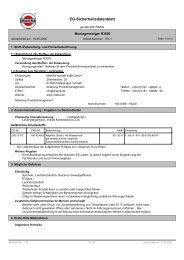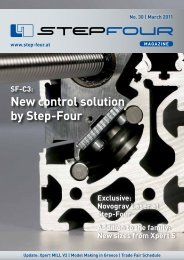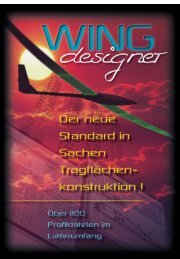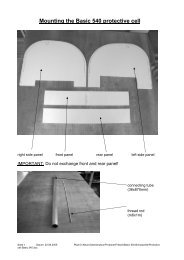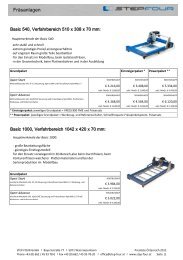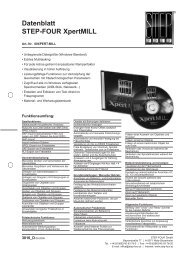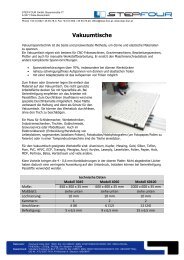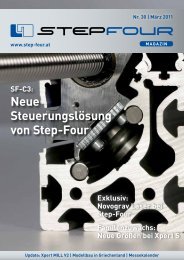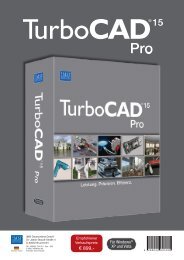Installation service by Step-Four Tips from the experts
Installation service by Step-Four Tips from the experts
Installation service by Step-Four Tips from the experts
You also want an ePaper? Increase the reach of your titles
YUMPU automatically turns print PDFs into web optimized ePapers that Google loves.
Rubrik<br />
The “Fairey Rotodyne” is ready for its maiden flight.<br />
An extraordinary scale model is created with<br />
<strong>the</strong> “Basic 540”<br />
Phillipp Gardemin <strong>from</strong> Baden-Württember,<br />
Germany,<br />
reports about building<br />
this helicopter model with<br />
<strong>the</strong> aid of a <strong>Step</strong>-<strong>Four</strong> Basic<br />
540. With a rotor diameter<br />
of almost three metres,<br />
this is a mighty big chopper.<br />
I dreamt for years about building a “Fairey<br />
Rotodyne” scale model. I flew this extraordinary<br />
helicopter in <strong>the</strong> late 50s, in England<br />
– but unfortunately this project didn’t<br />
get past <strong>the</strong> prototype status. This helicopter<br />
was extraordinary due to <strong>the</strong> fact that<br />
<strong>the</strong> almost 30 m main rotor was tip-driven.<br />
The tips were powered <strong>by</strong> a mixture<br />
of fuel and compressed air bled <strong>from</strong> two<br />
wing-mounted turboprops.<br />
The model was constructed at a scale of<br />
1:10. In order to be able to <strong>by</strong>pass <strong>the</strong> mechanical<br />
complexity of <strong>the</strong> tip drive, <strong>the</strong><br />
plan was to operate <strong>the</strong> model as an autogyro<br />
aircraft. This means that <strong>the</strong> rotor<br />
is driven <strong>by</strong> <strong>the</strong> airflow, thus, allowing <strong>the</strong><br />
model to take off. The first drawings were<br />
created on <strong>the</strong> CAD. The dimensions were<br />
<strong>the</strong>n taken over <strong>from</strong> a plastic model <strong>by</strong> <strong>the</strong><br />
Airfix company.<br />
Realisation with <strong>Step</strong>-<strong>Four</strong><br />
The fulfilment of <strong>the</strong> dream, however,<br />
could only take form with <strong>the</strong> acquisition<br />
of <strong>the</strong> “Basic 540” milling machine.<br />
The general layout drawings in <strong>the</strong> CAD<br />
gradually became a tangible plan. Thus,<br />
<strong>the</strong> individual parts separately drawn, exported<br />
to <strong>the</strong> milling software, and <strong>the</strong>n<br />
be directly milled. Only poplar plywood in<br />
thicknesses of four and three millimetres<br />
was used. The sheeting was made <strong>from</strong><br />
1,5 mm balsa.<br />
Ten month construction period<br />
During a construction period of over ten<br />
months, <strong>the</strong> milling machine became a<br />
best friend. Even <strong>the</strong> smallest of parts<br />
were drawn, exported to <strong>the</strong> milling software,<br />
and subsequently milled. The large<br />
cockpit, for instance, was quasi drawn<br />
<strong>from</strong> nothing in <strong>the</strong> CAD, <strong>the</strong> parts exported<br />
and milled. After a total construction<br />
period of twelve months, <strong>the</strong> model<br />
stood on <strong>the</strong> meadow, ready for flight.<br />
Two Hyperion external rotors with 4 blade<br />
airscrews <strong>from</strong> Varioprop and a 6s LiPo<br />
6500 mAh served for propulsion. The rotor<br />
blades – consisting of a Styrofoam cores<br />
with carbon reinforced plastic spars and<br />
plywood sheeting – rotated in a four-blade<br />
rotor hub <strong>from</strong> Varioprop and a self-built<br />
swivel mechanism. The entire model now<br />
weighed 10.5 kg.<br />
Test flights<br />
The “Fairey Rotodyne” was unfortunately<br />
unable to perform its maiden flight, which<br />
was due to <strong>the</strong> fact that <strong>the</strong> self-built autogyro<br />
mechanism wasn’t powerful enough<br />
for <strong>the</strong> enormous rotor diameter of almost<br />
three metres. The model is currently undergoing<br />
modifications, where<strong>by</strong> mechanical<br />
details are being improved upon, as<br />
well as <strong>the</strong> mechanic of <strong>the</strong> swivelling vertical<br />
tail fins. New test flights are planned<br />
for spring 2010. The “Basic 540” will certainly<br />
provide me with many more good<br />
<strong>service</strong>s until <strong>the</strong>n.<br />
Philipp Gardemin<br />
10 STEP-FOUR | March 2010


